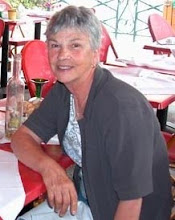










YUKON
During the summer, to relieve the monotony, we would often go to Whitehorse, the capital city of the Yukon. Near the town was Miles Canyon, a deep gorge that was very impressive. It had a foot bridge that made me very frightened. I remember the bridge being suspended on cables, making it wobble as you crossed. It was hard to keep my footing, and if I looked down to the bottom of the gorge, I would feel dizzy.
Also at Whitehorse on the river bank, there was an old, derelict paddle steamer, one of the stern wheelers that had operated on the Yukon River between Whitehorse and Dawson City between 1900 and 1950.
My Uncle Albert's visit and our trip to the ghost town of Atlin, BC, were two events that occurred that summer. I remember seeing at Atlin a small, very old fashioned fire engine that had to be pulled by a horse.
My Dad was very busy working on the bridge. He talked about it a lot over dinner. Dinners at our house were very important, if not for the food quality, then for the conversation. My Dad always included Suzanne and I, and often we would talk about serious matters. I remember conversations about the Korean War and several about the Depression.
In Teslin, I learned a lot about bridge construction. For instance, there were several cofferdams installed in the water where the bridge was to be located. I believe these were made of steel and placed below the water level. The purpose was to create large square spaces that could be kept dry, enabling men to work inside them. Here, I believe, long wooden piles were driven and the concrete piers that would ultimately support the bridge were poured.
I remember my father, with great anxiety, monitoring the level of the water outside the cofferdams, as the spring melt came down into the Bay that summer. He took great pride in precise documentation, which he regarded as an essential attribute for engineers and also desirable in wives and children, along with orderliness, punctuality and efficient use of time. I can still remember his almost daily reports of continuously increasing water levels which came very close to causing flooding of the cofferdams.
One of the most embarrassing moments of my life occurred in Teslin. Colonel Brown and another government official from Ottawa came to check on progress at the bridge. My father entertained them in our small two-bedroom apartment above the school. Suzanne and I were in also in the living room, when my father mentioned a man whose name was very familiar. I immediately said, "Oh, that's the stool pigeon." If looks could kill...
Of course, even though I was 14 years old, I didn't know what a stool pigeon was or that this man was being paid by my father to spy on the contractor. I did discover what this was all about later, when my father explained in no uncertain terms what he expected of his daughter.
It transpired that the contractor had been cheating on the amount of cement he was putting in the concrete. I'm sure that Colonel Brown would have approved of my father having a spy if that's what it took to protect the integrity of the bridge.
In the photos are:
1) The old bridge at Teslin.
2) With fireweed at the side of the road.
3) The new Nisutlin Bay bridge.
4) Piling for Pier 3, Teslin Village in the background.
5) Pier 3 Cofferdam, January 31, 1954.
6) Pile driver hammer, August 25, 1955.
7) Working in Cofferdam #7, September 3, 1955.
8) Nisutlin Bay Bridge, January 10, 1954, looking north from existing old bridge.
9) Cofferdam #7, September 19, 1955.
10) Bearing Piles, Nisutlin Bay Bridge, August 17, 1955.
11) Alaska Highway Mile 804 looking north down the hill towards Teslin village on the point.


No comments:
Post a Comment